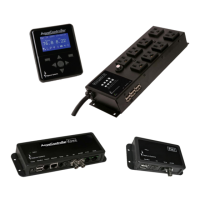Apex Classic Setup and Programming Guide v2.2 Page 52
This will make Sump_Low turn on and off in response to the float switch which
can be included on a Status Screen or referred to in other outlet programming. In
addition, creating Virtual Outlets for switch inputs that have meaningful names
makes programming and reading your program much easier as you do not have
to remember that “Switch1” is your sump low switch.
Another possible use for Virtual Outlets is to create timing signals to trigger
events on other outlets. Take for example, you would like to oscillate an outlet
between 2 pump Profiles. Create a Virtual Outlet to create the timing signal when
to switch Profiles:
<Virtual Outlet Timer>
OSC 0:00/30:00/30:00 Then ON
<Outlet Pump>
If Timer = ON Then PF1
If Timer = OFF Then PF2
This will cause Pump to switch between PF1 and PF2 every 30 minutes.
ORDER OF OPERATION
The order commands are listed in most outlet programs is not important,
however, there are some cases in which order is important. For example, the
order of the command in this program are not important:
If Temp > 80 Then OFF
If Temp < 78 Then ON
The order of these 2 commands is not important as the conditions that make
each of these commands true will never compete with each. They will never
compete with each other for “control” of the outlet. However, consider these
commands:
If pH > 8.50 Then OFF
If Outlet Light1 = ON Then OFF
If Switch1 CLOSED Then ON
If Switch1 OPEN Then OFF

